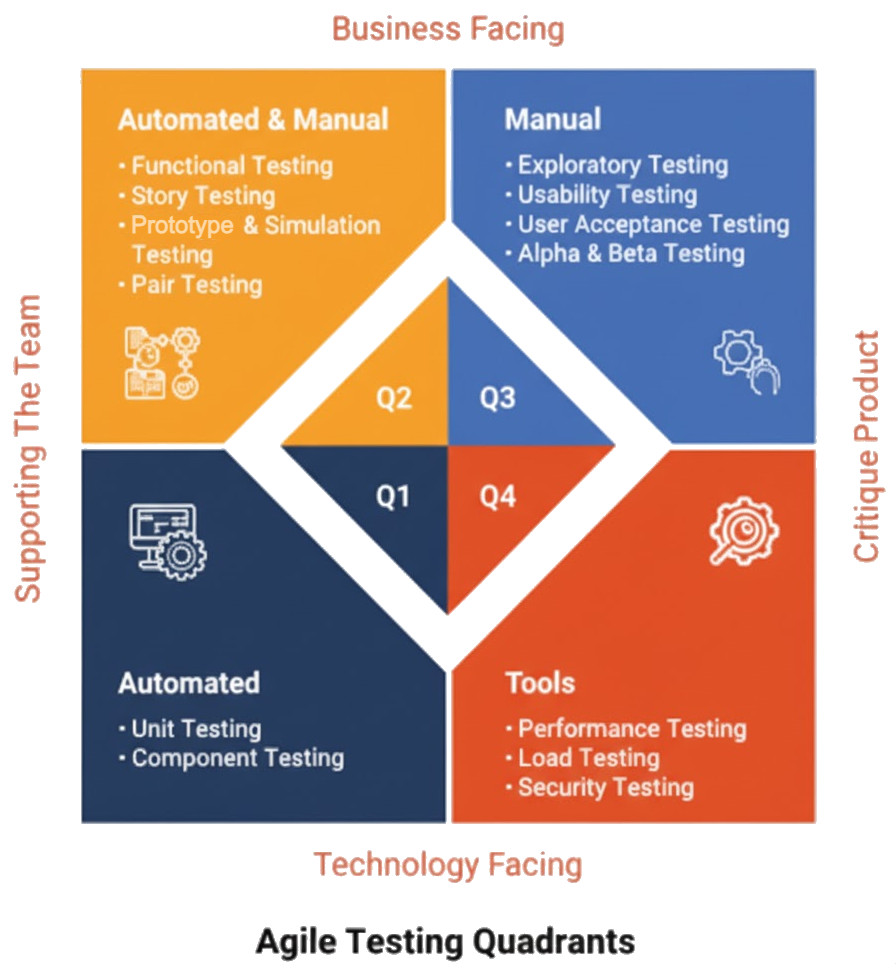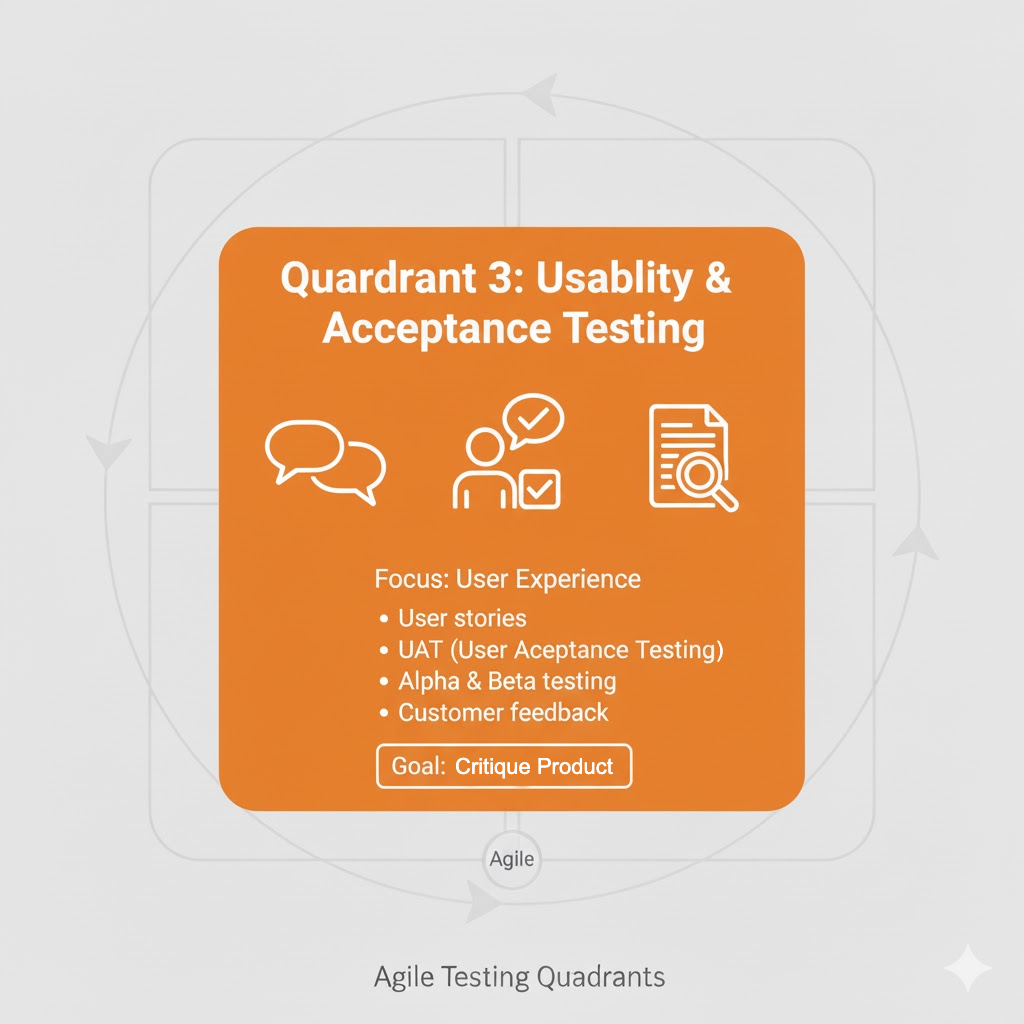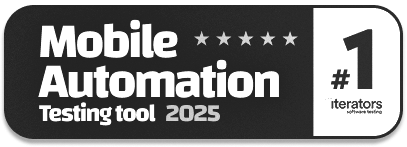What are Agile Testing Quadrants
|
|
In today’s software engineering, agility is not a decision but a prerequisite. Teams rapidly, continuously, and in real-time accept changes. Yet, with the rapid acceptance of changes comes complexity. One of the frequently asked questions is: What can be done to ensure quality in the Agile lifecycle?
From the test strategy perspective, this approach follows a clear and structured method. But at the same time, it is flexible and adaptable to the changes within the context of the iterative and collaborative work. The strategy is aligned with the Agile Testing Quadrants concept to assist developers in structuring testing and prioritizing activities.

The paradigm can be seen in the Agile Testing Quadrants, which was first devised by Brian Marick, refined by Lisa Crispin, Janet Gregory, and provides the modes of thought to link the testing practices. Their goal is not to prescribe exact testing practices, but to provide guidance for the team to understand what needs to be tested, why it needs to be done, and when it must be tested.
| Key Takeaways: |
|---|
|
The Philosophy Behind Agile Testing
It is important to first know the key differences between Agile testing and traditional testing before delving into the quadrants.
From Validation to Collaboration
Conventional testing was generally done post-development. The role of the tester was to test the software against the requirements, usually towards the end of the lifecycle. This slow feedback introduced bottlenecks and expensive defect resolution.
Agile flipped that model. The process of testing has become continuous and cooperative. It does not occur after development but with development. Quality is shared by testers, product owners, and developers. And they work in an iterative manner to make each increment potentially shippable.
Read more about: The Role of QA in Agile Development.
Quality as a Continuous Goal
Quality is not inspected at the end but built in; this is the fundamental concept of Agile. It’s a mindset, not a phase.
- The Agile framework breaks development processes into sprints, each ending with a working product increment, enabling tangible and regular progress checks on the project’s goals and their alignment.
- The working software prototype is constantly evaluated for functionality, performance, and business value to safeguard continuing reliability and efficiency, and user relevance.
- Learning and improvement are driven by continuous feedback loops, enabling teams to adapt quickly and enhance both the process and the product with every iteration.
Therefore, agile testing is a relentless quest for quality, which necessitates an orderly and flexible model. The Agile Testing Quadrants do just what they promise by offering a solid framework for organizing test-related efforts at each stage of the agile lifecycle.
Understanding the Agile Testing Quadrants
The Agile Testing Quadrants model breaks testing down into four independent but correlated areas. Each quadrant performs different functions, serves different target users, and gives different feedback.
At a high level:
- Quadrants Q1 and Q2 help in the development process; they are technology-facing and help the team develop the product correctly.
- Quadrants Q3 and Q4 help challenge the product, as they are business-facing, enabling one to make sure they develop the right product.
These quadrants collectively present a complete picture of testing, and there is no important element of testing, be it functional, technical, or user-centric, that is not taken into consideration.
Read more about: A Roadmap to Better Agile Testing.
The Four Agile Testing Quadrants in Detail
We will take a closer look at each quadrant, its focus, methods, purpose, and the way they complement each other.
Quadrant 1: Technology-Facing Tests that Support Development
- Primary Objective: To ensure the correctness and stability of the code, enabling fast and reliable feedback during the development process
- Focus: Tests in this quadrant level center on individual functions or components to ascertain their correctness and performance.
-
Audience: The target audience is composed of build systems and developers who should receive regular and quick results from these tests to follow the performance of the code.

Purpose and Nature
The first quadrant focuses on embedding quality in the code. This covers tests that check if individual parts of the system or units have been correctly implemented. These tests are low-level and fast, with a high level of automation. The goal is to catch a particular failure as early as feasible, ideally before it escapes the developer’s environment, thus ensuring a solid foundation for further development.
Key Activities
- Unit Testing: Verifies the small isolated pieces of code, with the focus on verifying that the isolated code behaves as intended.
- Component and API Testing: Testing that individual modules and APIs run together as outlined within their contracts.
- Static Code Analysis: Done to detect syntax errors, security vulnerabilities, and code errors early in the development lifecycle
- TDD (Test-Driven Development): Involves developing tests before writing the actual code, giving an approach in which the test informs the design and implementation. Read: What is Test Driven Development? TDD vs. BDD vs. SDD.
Why it Matters
Quadrant 1 is the Agile testing basis. Without this, teams get into technical debt very fast. Such tests provide developers with the confidence to refactor and evolve code safely, something that is non-negotiable in continuous integration and fast release cycles.
Quadrant 2: Business-Facing Tests that Support Development
-
Primary Objective: The primary objective of Quadrant 2 is to determine whether the system’s functionality matches the defined business requirements.

- Focus: This quadrant is oriented towards the story-level tests and functional tests to guarantee that the product meets its expected behavior without exception.
- Audience: The main audience for these tests includes product owners, business analysts, testers, and developers.
Purpose and Nature
This quadrant is designed to determine whether the system behaves in the way the stakeholders anticipated. Because the tests in this quadrant are expressed in business language, they are comprehensible to all personnel, including non-specialist stakeholders. As a rule, these tests are a derivative of user stories and acceptance standards and assist in verifying that the creation lines up with consumer and business expectations.
Key Activities
- Functional Testing: This activity verifies complete end-to-end workflows to ensure the system works properly.
- Acceptance Testing: This activity ensures that user stories work according to the acceptance criteria and are released.
- Example-Driven Development (EDD): It explains requirements using practical examples in advance to show how the code should work.
- Behavior-Driven Development (BDD): The definition of behavior in a human-readable language, such as Gherkin (Given–When–Then).
Why it Matters
Quadrant 2 is important for reducing the language barrier between business and engineering. By creating test scenarios upfront, individuals get to a common understanding of what needs to be done. Quadrant 1 informs us that requirements can change. This, in turn, helps avoid mistakes, reduce the redo, and get feedback on time to see if the feature brings business value.
Quadrant 3: Business-Facing Tests that Critique the Product
- Primary Objective: The main goal of Quadrant 3 is to ensure the proper functioning of the system in real-life situations with a convenient user experience.
- Focus: This quadrant is centered on exploratory and user-related types of tests, which can help identify previously unknown sources of risks and usability flaws.
-
Audience: Such tests should be conducted by audiences who regard customers and end-users, namely testers and UX specialists.

Purpose and Nature
Quadrant 3 is the one in which testers are moving to exploration. Q2 will ensure that the system is performing as expected, but Q3 will reveal its response in unforeseen circumstances.
Such tests provide answers to questions such as:
- Does the product address actual user issues?
- Does it have an intuitive and satisfying experience?
- What is its performance in real-life situations?
Key Activities
- Exploratory Testing: This is an approach where, concurrently with learning and design, testing is performed on a system in order to detect peculiar behavior and usability defects.
- Usability Testing: It focuses on how actual consumers utilize a product and assesses the general experience and ability to access the product.
- User Acceptance Testing (UAT): Checking the preparedness on the side of the customer.
- Alpha/Beta Testing: This involves gathering feedback from early adopters to validate product performance and usability before a full release.
Why it Matters
Quadrant 3 is critical for achieving higher customer satisfaction and sustainable market performance. It introduces a truly human-centered dimension to the testing process, tracking value based on actual usage rather than hypothesis. Hence, the test demonstrates that the product complies with the specified requirements in practice rather than in the abstract, improving quality and trust on the end-users’ side.
Quadrant 4: Technology-Facing Tests that Critique the Product
- Primary Goal: The primary purpose of Quadrant 4 is to evaluate the system’s non-functional characteristics, including performance, security, scalability, and resilience.
- Focus: This quadrant emphasizes assessing technical quality, intending to test the system’s robustness via load and stress testing
-
Audience: The categories of users exposed to such testing include test engineers, DevOps professionals, architects, and security personnel, who determine the system’s strength and dependability.

Purpose and Nature
The goal of this quadrant is to check the strength, stability, and endurance of the system. It conducts non-functional testing checks to confirm that the product operates well, is compliant, and is also secure in various conditions. In particular, this test assesses a system’s performance when overloaded and its ability to recover from an unexpected error caused by external factors.
They help answer essential questions such as:
- Is the system capable of handling high traffic?
- Is it secure from attacks?
- What does it do in case of failures or recoveries?
Key Activities
- Performance and Load Testing: To evaluate how much time a system takes to respond, how many users can concurrently use the system, the maximum number of users that may use a system at a time, etc., needs to be calculated. Read about What is Performance Testing: Types and Examples.
- Security Testing: To identify as many threats as possible that could break into the system, and ensure compliance with security standards. Read more on Security Testing.
- Disaster Recovery and Failover Testing: Check whether the system can handle any critical condition during system failure and check retrievability with multiple systems.
- Compatibility Testing: Make sure that the product behaves as expected in other browsers, gadgets, and environmental situations.
Why it Matters
Performance and security are not luxuries in the digital age, but they are trust factors. Quadrant 4 makes the product resistant to the real-life demands and threats, creating trust among the users and the stakeholders.
The Relationship Between the Quadrants
The four Agile Testing Quadrants are not separate, but rather, they interact seamlessly. These connections show that Agile testing is not linear but cyclical, relying on continuous communication and feedback.
Quadrants 1 and 2 are both preventive and designed to assist teams with the development of the right product in the right way by establishing necessary code quality and linking the latter to the business requirements. Quadrants 3 and 4 are evaluative and designed to check the quality of a product after it has been developed by verifying if it can provide real-world value to the customer and stay reliable and resilient.
Thus, all four quadrants create a 360-degree view of quality, starting from the integrity of the code or final product and ending with the experience of the customer.
Let’s consider an example: The feedback from Quadrant 3, which is aimed at user experience, can be utilized to modify and enhance the acceptance tests from Quadrant 2. Similarly, the performance issues found in Quadrant 4 help in refactoring and further validation of tests from Quadrant 1.
Such a holistic nature of dependence results in a cohesive feedback loop, making testing a constant reality of learning and improving, a foundation of Agile quality assurance.
Overview of the Four Agile Testing Quadrants
| Quadrant | Type & Orientation | Primary Objective / Purpose | Focus Area | Audience / Participants | Key Activities |
|---|---|---|---|---|---|
| Q1 | Technology-Facing Tests that Support Development | Ensure code correctness, stability, and early defect detection | Low-level, fast, automated testing at the component or unit level | Developers, Build Systems, Test Engineers | Unit Testing, Component Testing, API Testing, Static Code Analysis, Test-Driven Development (TDD) |
| Q2 | Business-Facing Tests that Support Development | Validate that functionality aligns with business requirements | Functional and story-level testing | Product Owners, Business Analysts, Testers, Developers | Functional Testing, Acceptance Testing, Example-Driven Development (EDD), Behavior-Driven Development (BDD) |
| Q3 | Business-Facing Tests that Critique the Product | Evaluate user experience, usability, and real-world behavior | Exploratory and user-related testing | Testers, UX Designers, End-Users | Exploratory Testing, Usability Testing, User Acceptance Testing (UAT), Alpha/Beta Testing |
| Q4 | Technology-Facing Tests that Critique the Product | Assess non-functional attributes like performance, security, and resilience | Non-functional and system-level testing | Test Engineers, DevOps, Architects, Security Experts | Performance Testing, Load Testing, Security Testing, Compatibility Testing, Disaster Recovery, and Failover Testing |
Integrating the Quadrants into Agile Workflows
In practice, the Agile Testing Quadrants are not separate phases or teams; they operate together within each sprint. Thus, successful integration requires careful planning, strong coordination, and smart automation to ensure that quality is built and validated continuously.
Planning Testing Across Quadrants
In a sprint planning, the team identifies which quadrants each user story coincides with to attain comprehensive coverage. The duties are shared too, where developers are in charge of Q1 and Q2, while Q3 is left for testing, and Q4 is reserved for performance teams. The team likewise chooses what aspects should be automated and what areas need exploratory investigation, making a balanced and efficient testing strategy.
Continuous Testing in CI/CD Pipelines
Automation is crucial for continuous testing under Agile. Q1 and Q2 tests are added to the CI/CD pipeline and provide instant feedback on code changes. Similarly, Q3 exploratory sessions are carried out on each release candidate to review the overall user experience. Q4 non-functional tests are executed periodically or via parallel pipelines to check or assess performance, scalability, and security.
Collaboration and Shared Ownership
All four quadrants have multiple roles, such as developers, testers, UX designers, and product owners. This collaboration results in every product aspect being tested and validated from different views. It eliminates testing gaps by having shared quality ownership across teams, creating a more organized culture of responsibility and relentless reinvention.
The Strategic Impact of Agile Testing Quadrants
The quadrants were not meant to be a way of structuring how testing is done, but they reframe the way an organization thinks about and prioritizes quality. This means that teams are meant to see testing as an ongoing, meaningful process that is embedded in development rather than an isolated component that is checked off the list.
- Balance and Visibility: They indicate where the testing effort is concentrated. Are we testing the units too much, and don’t test the user experience? The quadrants show imbalances that affect the quality overall.
- Improved Communication: The quadrants give rise to a shared language between business and technical departments. Instead of “What type of test do we need?” in seconds, the teams will be able to indicate a quadrant on the board that clarifies everything.
- Better Risk Management: All the quadrants address the various risks, such as functional errors, user dissatisfaction, or system failure. To fully mitigate risks, all four quadrants must be included.
- Strategic Test Automation: The quadrants direct where the priorities for automation should be. For instance, Q1 and Q2 are well automated. In most cases, Q3 and Q4 are more about manual exploration rather than automated monitoring.
Read more about Higher Failure Rates for Agile Software Projects: A Comprehensive Analysis.
Conclusion
The Agile Testing Quadrants, however, are not just a diagram, but instead a philosophy of balance, visibility, and collaboration in making quality happen. It is a constant reminder to teams that quality is best when defined from unit accuracy to a fully end-user empathy requirement. Quality is made up of the combination of functional precision and operational resilience. Thus, they can be considered a guiding framework that allows teams to always rely on validated effort in each sprint, each release, or each innovation.
| Achieve More Than 90% Test Automation | |
| Step by Step Walkthroughs and Help | |
| 14 Day Free Trial, Cancel Anytime |












